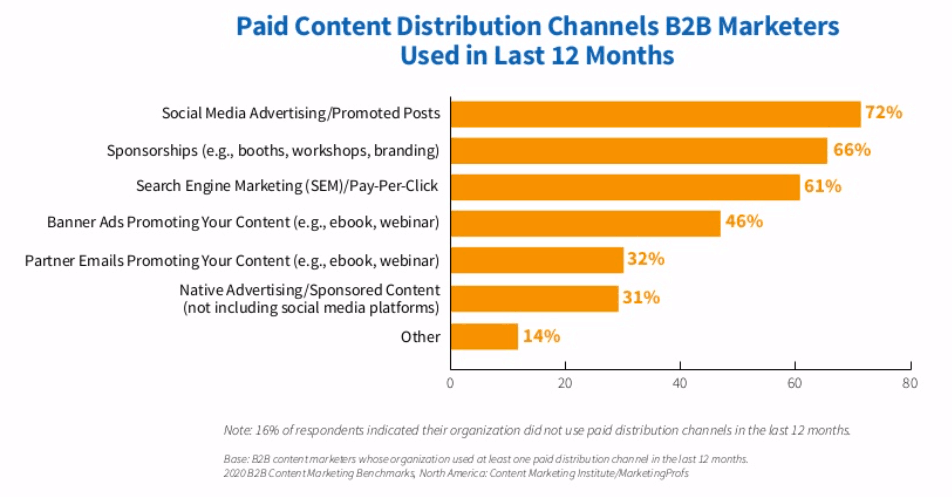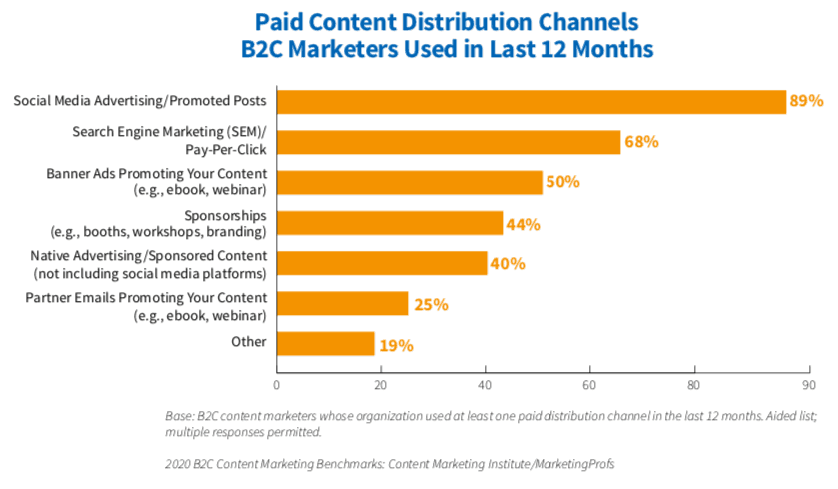
“How can a Google Ads campaign work best to convert responders?”
A marketer from SEI Investments Company asked, “How can an AdWords (now called Google Ads) campaign work best to convert responders?” It’s among the Top 100 Questions on content marketing.
Google Ads is an online advertising platform from Google. Companies pay to display brief advertisements that link back to their websites. The ads pop up when people search the web for that topic or question.
Google Ads belongs to an advertising category called Search Engine Marketing (SEM). SEM can be an effective part of your overall content marketing distribution strategy.


As you can see above, recent research from the Content Marketing Institute and MarketingProfs revealed that about 60% of B2B and 70% of B2C marketers use SEM.
And one of the most popular forms of SEM is Google Ads.
“While display, social and video tactics can effectively generate awareness and guide discovery, Google Ads plays a heavier role in the consideration, engagement and conversion stages of the marketing funnel,” says Gosia Pawlak, paid search supervisor at 90octane. “Intentional and targeted, Google Ads can effectively generate qualified leads and close sales.”
In fact, Pawlak believes these ads should be at the top of every marketer’s conversion list for 4 reasons:
-
Google Ads produces fast(er) results.
While organic search engine optimization (SEO) efforts take time, Google Ads can act as a complementary tactic that brings immediate traffic to your site. Bids, targets and project scope can be updated within minutes.
-
Google Ads helps generate more qualified leads.
By strategically picking the keywords you bid on, you are “pre-screening” leads that come through paid efforts. This means that the traffic from these ads is likely to be more qualified.
-
Google Ads provide measurable results.
With these ads, you can clearly measure every aspect of your campaigns including the number of clicks, the cost per click, and how many leads or sales are coming from these clicks. This helps make better use of your ad budget and find ways to improve results over time.
-
Google Ads improves brand recognition.
Pay-per-click (PPC) ads on Google can also improve brand awareness over time. They improve your search engine visibility and communicate differentiation points swiftly and effectively with extended ad descriptions and other options.
Clearly, Google Ads can be an important and effective part of your paid content strategy. To ensure you’re using Google Ads effectively to gain the most conversions, follow these tips:
Provide only relevant links
Using Google Ads can be a useful tactic for driving traffic to your website, as long as you provide a relevant link.
“In general when you use Google Ads it’s all about where you drive your buyers,” says Carly Bromberg, marketing campaign development lead. “Focus on the way you write the ad to directly align to the content on the page. For example, if you’re advertising pizza, the ad should link directly to a page about pizza, not to the home page of an Italian restaurant.”
Ensuring direct connections could increase your quality score—it’s a factor in what moves you up the list of search results (in addition to how much you spend).
Use the right keywords
Amanda McDonald, data-driven marketing expert, offers these tips for success with your ads campaign:
- Understand your 10 most important keywords, and ensure your website is optimized for those words. The keywords in your ads must also appear on the page where the ad drives searchers.
- Ensure there is significant search volume around your keywords. If you’re not sure, test!
- Find and own long-tail keywords specific to your product or service. Long-tail keywords are less expensive, usually give you a higher ranking, and do a better job converting searchers. If you bid on broad keywords, it will be difficult to outbid bigger brands with bigger budgets. Going back to our pizza example, since pizza is a broad keyword, consider “thin crust pizza” or “Chicago style pizza.”
McDonald also advises marketers to continually test both their ad copy and their calls to action and make adjustments as needed.

Consider retargeting
If you set up your Google Ads with the proper tracking codes, you can remarket to people who previously clicked on your ad. Retargeting saves time and money in the long run, especially if people rarely buy the first time they visit your site.
SEM is one of the most popular and effective paid marketing tactics, and Google Ads is by far the most frequently used SEM channel. Using the right keywords, ensuring you link to relevant landing pages, and retargeting can all help increase conversions with Google campaigns.
Want to make the most of Google Ads but don’t have internal expertise?
“Working with a trusted digital expert can help you stay on top of new trends and take your business to the next level,” says Pawlak.
“How can an AdWords campaign work best to convert responders?” is one of the Top 100 Questions on content marketing.
You’ll find the answers here.
For more tips on content marketing and communications, subscribe to our blog.





